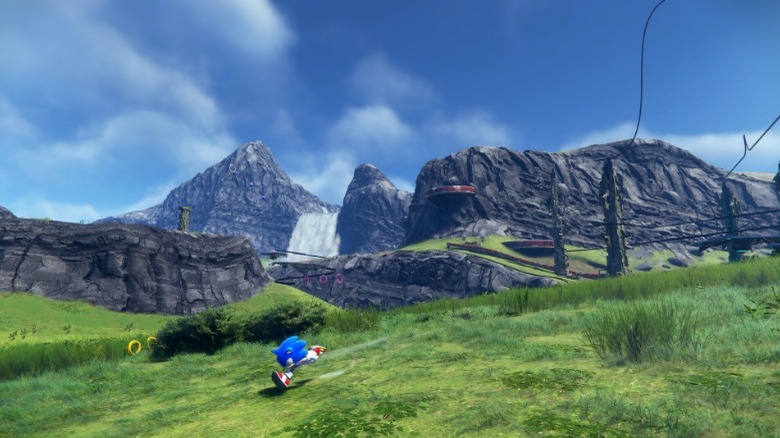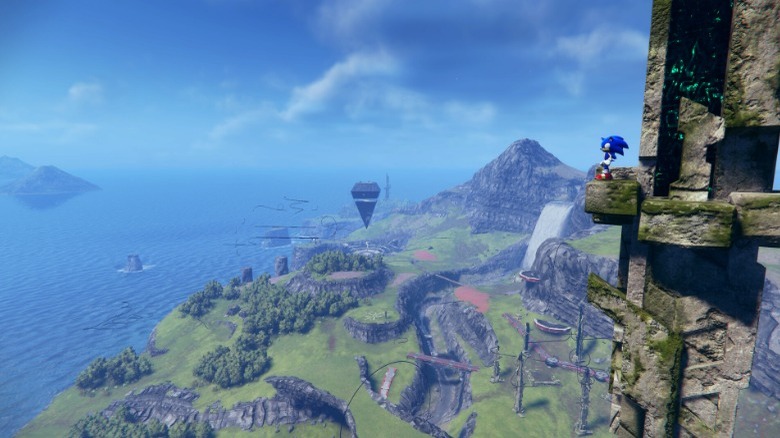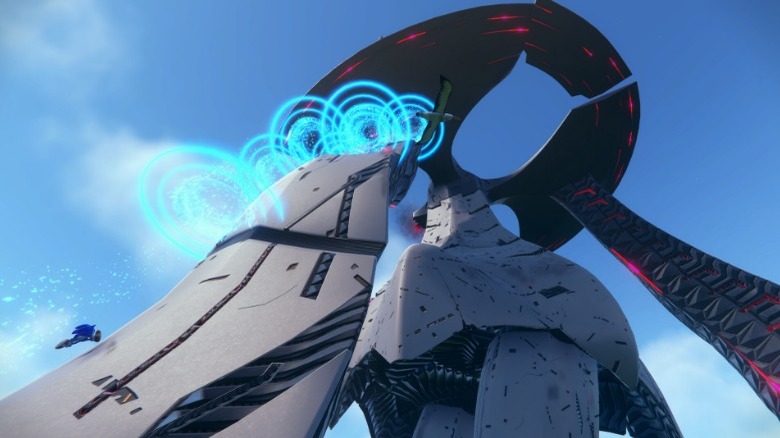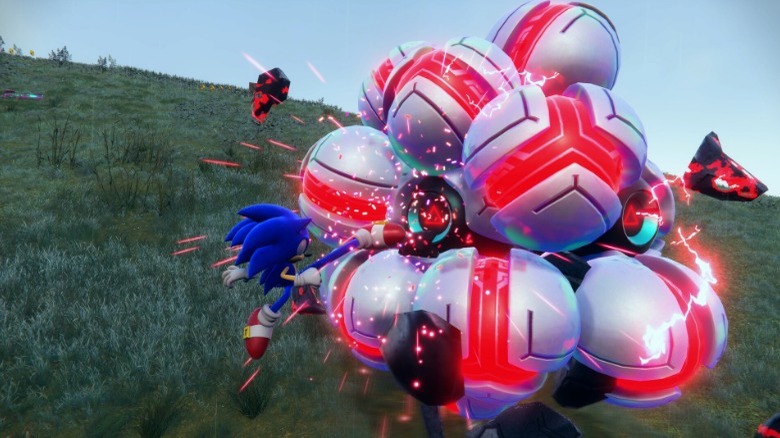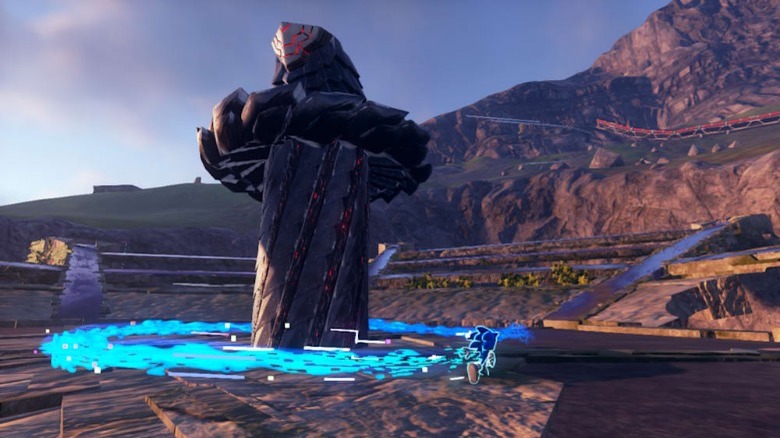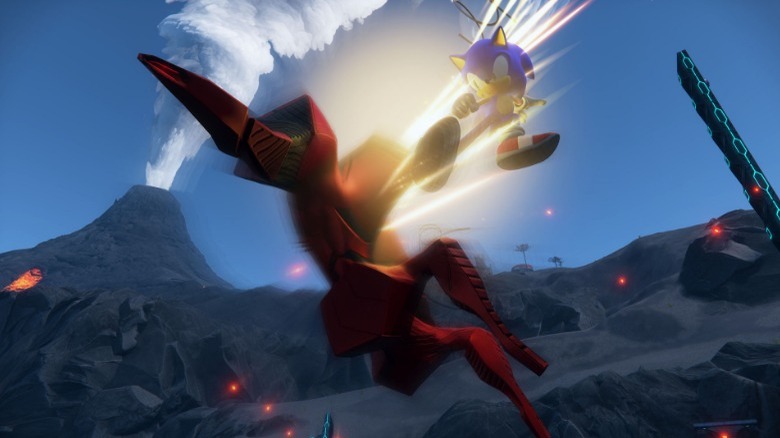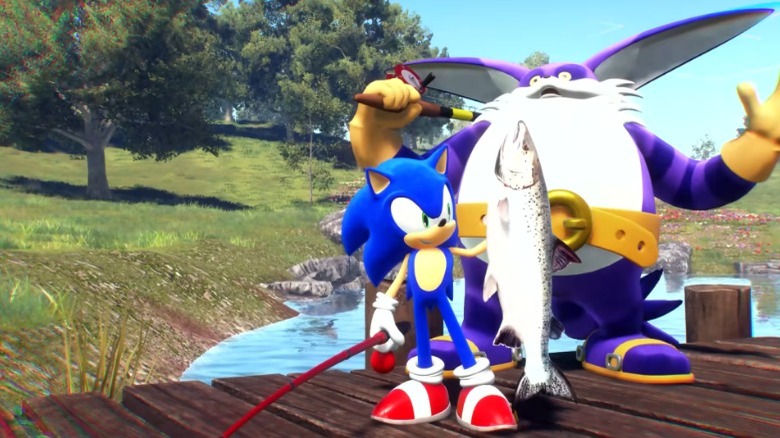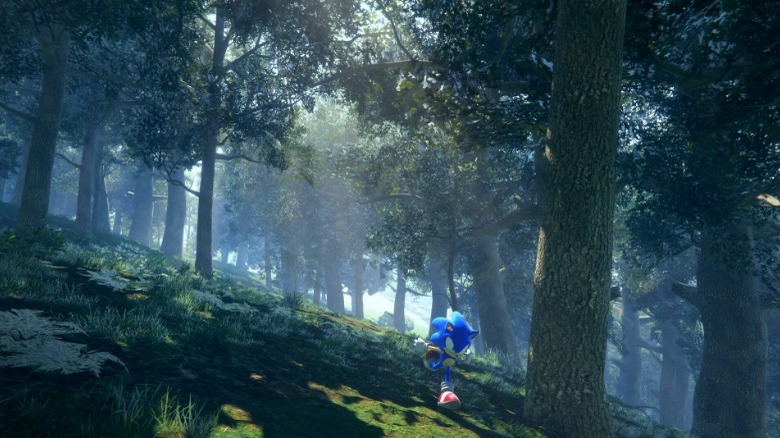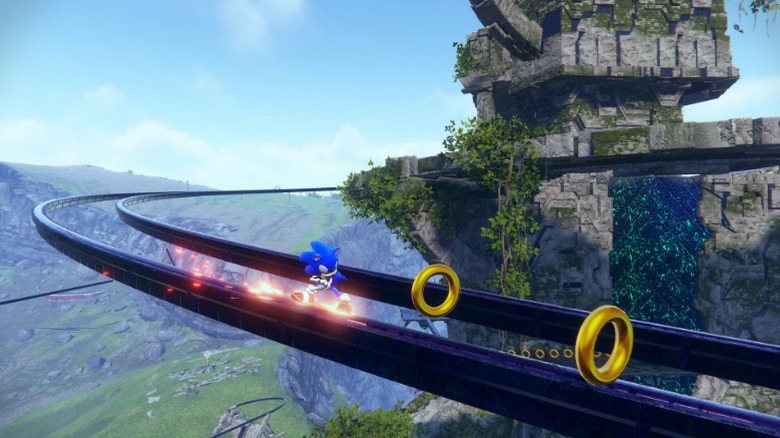The Best And Worst New Features In Sonic Frontiers
Some franchises try to stick to reliable formulas, while others are a little more experimental. "Sonic the Hedgehog" games sit squarely in the latter category. The newest "Sonic" sequel, "Sonic Frontiers," sticks to a reliable pattern of reinventing the wheel — for both good and bad.
Critics have been mixed on "Sonic Frontiers," but many early reactions have been generally positive. The title has plenty of strong ideas that are novel to the franchise, but it is held back by some not-so-great ones that are just as new. As a result, "Sonic Frontiers" is functional and fun, but it doesn't quite hold its own against the series' best entries. Then again, that's more than can be said for other "Sonic" titles (cough "Sonic '06" cough)
The consensus seems to be that if Sonic Team were to develop a sequel that accentuated the best features in "Sonic Frontiers" and fixed the worst ones, the developers might have a gem on their hands. Here are the additions to the "Sonic" formula that the general gaming public loved and hated.
BEST: Open Zones
Sonic is known for going fast; it's part of his general appeal. However, in previous games, he only got to run in linear levels with a few branching paths. "Sonic Frontiers" is Sonic's first step into the semi-open world formula, at least in spirit. And wouldn't you know it — it's a good fit!
Instead of going for an actual open world, "Sonic Frontiers" takes the "Pokemon Legends: Arceus" approach and splits the larger game world into several sprawling levels. That's hardly a complaint, though. As noted by reviews from outlets like GameXplain, each zone gives players more than enough room to run at Sonic's top speed, which easily gets the heart racing.
And there's a lot for Sonic to do in this brave new world. While running through open zones is exciting on its own, since these areas are so large and expansive, players can also pick any direction and find a bevy of collectibles, puzzles, and powerful enemies. Each challenge provides a tangible burst of adrenaline, as well as a sense of exploration that has been missing from previous "Sonic" games. Getting distracted by obstacles is half the fun of "Sonic Frontiers," largely because they are so plentiful, easy to find and conquer, and largely enjoyable.
Even though "Sonic Frontiers" isn't a true open world, it nails the feeling of one. You never know what's around the corner, but you know it will keep you entertained as much as the process of finding it.
WORST: Open Zones
The open zone design is a bit of a double-edged sword. Open worlds are also a common source of flaws in modern video game design, since studios often cram large, explorable levels into games without always ensuring they make sense — or that game engines can support them. "Sonic Frontiers" is the latest game to suffer from this problem.
Open zones in "Sonic Frontiers" are fun, but outlets such as gameranx and Skill Up have pointed out that aesthetics have been sacrificed in the process. "Sonic" games are usually cartoonish and colorful, full of weird contraptions and themes, but "Sonic Frontiers" can be artistically bland in comparison. Each open zone looks generic, and while locales are full of grind rails and floating platforms, these can sometimes lack any cohesion with the world around them. Most players might assume they will speed by too quickly to notice, but doing so causes another problem.
Arguably the biggest issue in "Sonic Frontiers" is pop-in. Either due to engine problems or Sonic's speed (or both), some obstacles can take several seconds to render onto the screen, which gets in the way of exploration and forces players to take leaps of faith. Gamers have posted on Reddit to complain about the issue, and some reviewers have gone so far as to claim that the pop in is the worst they've ever seen.
If you want to see a "Sonic" game with an open world ripe for exploration that doesn't suffer from bland design or pop in, you might want to play a fan game like "Sonic Utopia."
BEST: Guardians
When Sonic Team upended the franchise's design philosophy with open zones, the developers also created whole new avenues for gameplay. Not only could designers invent challenges impossible in previous "Sonic" games, they also could finally redesign bosses to be more than just end-of-level challenges to be stomped on.
While "Sonic Frontiers" has requisite giant bosses that cap off each open zone, the most challenging fights come in the form of field bosses, otherwise known as Guardians. These enormous enemies are sprinkled throughout the zones, and critics have praised these enemies for the ways in which they provide unique challenges. For instance, the Strider and Caterpillar guardians task players with grinding on rings while dodging incoming fire, while the Sumo guardian tests players' skill with ricocheting spin dash shots.
While Skill Up's review was highly critical of "Sonic Frontiers," it gave credit where credit was due and praised the Guardian fights. He likened some of the field bosses to the enemies found in "Shadow of the Colossus." While he seemingly didn't intend that comparison as a compliment in this case, it is actually a solid summary of the "Sonic Frontiers" Guardians. Each field boss is a miniature "Sonic" level or puzzle in its own right, in addition to a bonafide fight, which is a solid new direction for the series. Here's hoping the Guardians serve as blueprints for future "Sonic" game bosses.
WORST: Combat
Then again, when someone plays a "Sonic" game, they typically expect to blaze through levels as quickly as possible, not methodically fight enemies with combos and counters. However, Sonic Team implemented a dedicated combat system in "Sonic Frontiers," and the execution has left something to be desired.
As players explore the open zones of "Sonic Frontiers," they will also fight numerous faceless enemies. The most reliable way to defeat these robotic opponents quickly is through punches, kicks, and combos. Unfortunately, many players have found the system too basic, which is saying something given many modern "Sonic" titles have simply used a homing attack for combat.
Outlets such as gameranx and GameXplain have derided the combat system for being too mindless and button mash-y. Arguably the worst aspect of battles is the parry mechanic. Normally, players are supposed to press the block button right before or when an enemy's attack lands, which makes parrying a high risk and high reward endeavor. However, "Sonic Frontiers" ignores any sense of block timing; just press the shoulder buttons to parry an attack. Players can hold down these buttons as long as they like, and they can counter attacks without any worry. This design choice unintentionally robs many fights of challenge.
Some reviewers decided to avoid as many fights as possible and just spend their time in "Sonic Frontiers" rolling around at the speed of sound. When a parry mechanic trivializes fights, can you blame them?
BEST: Cyloop
Since "Sonic Frontiers" features a dedicated combat system and RPG-like progression, players can unlock a slew of new abilities to use in battle. One of the earliest combat skills available is arguably one of the best abilities in the game.
The Cyloop skill is new to the world of "Sonic." Unlike legacy skills, which mostly involve Sonic curling into a ball, Cyloop consists of Sonic literally running circles around opponents. Thanks to some video game logic, that circle damages anything inside it. This ability is crucial for breaking through enemies' guards, but unlike many other "Sonic Frontiers" skills, Cyloop also serves a purpose outside of combat.
A number of puzzles in "Sonic Frontiers" also rely on the Cyloop. These are usually as simple as just running around an odd brazier or two (or another object) to reveal a nearby secret. But even when the game doesn't hide a collectible, players can typically just Cyloop around, and something is bound to happen. Sonic can even dig up rings just by tracing Cyloop circles in random patches of land.
Some reviewers enjoyed the Cyloop enough to hope it returns in future "Sonic" games with even more utility. It's hard to ask for a better endorsement.
WORST: Action Style Mode
Some difficulty modes in video games merely buff the defense and attack power of enemies, while other modes alter how a game controls. On paper, this sounds like a great idea, but when established franchises like "Sonic" try to add one, things sometimes don't go according to plan.
When players start up "Sonic Frontiers," they can pick between "High Speed Mode" and "Action Style Mode." The former offers the standard, turbo-centric action "Sonic" veterans are used to — within the limits of the game engine, that is. The latter, meanwhile, is slower, much to the disappointment of reviewers.
Some reviews have gone so far to claim that Action Style Mode is downright pointless. When using this mode, the game progresses at a snail's pace, and Sonic is way too slow to effectively explore the open zones, even when using Power Boost. Gameranx argued that slowing down gameplay in a "Sonic" title is antithetical to the very point of the franchise: going fast. Sure, platforming and combat are technically easier in Action Style Mode — or at least they're supposed to be — but as many reviewers have pointed out, "Sonic Frontiers" is at its best when players can cut loose and just run around the open zones and levels, not when they stop to kick enemies into next year.
High Speed Mode lets players experience the best "Sonic Frontiers" has to offer at speeds that accentuate the rush of adrenaline the game already provides. Action Style Mode, meanwhile, arguably dilutes the experience.
BEST: Fishing
The bigger and longer a game, the more likely players will need a break from the action. An eight-hour adventure featuring Sonic racing around levels sounds nice, but 30 hours? That could be a little too long. Luckily, "Sonic Frontiers" offers a side activity that lets players relax and even ease the grind.
Each open zone in the game houses a portal to a pond overseen by Big the Cat. While there, players can partake in a simple (yet fun) fishing mini-game. Participating is as easy as aiming for fish, tossing a line, and pushing a button to hook a fish and reel it in with Sonic's signature flair. Each cast costs one purple token (which can be collected in various places on the map), but the rewards far outweigh the price of admission.
Fishing ponds in "Sonic Frontiers" house a number of rewards, most of which are fish. Unless players hook something like a scroll, everything in the pond rewards them with tokens and tickets, which they can then trade for upgrade resources and other collectibles required to finish the game. This might sound like a cheap way to complete "Sonic Frontiers," but it isn't. Fishing is simply an enjoyable alternative method to collect resources.
Gamers who love the grind can safely ignore the fishing ponds, but those who don't can use them to acquire the same level of power.
WORST: Upgrading Stats
Stats are an important part of player progression. What better way to make players feel more powerful as time goes on than letting them upgrade damage output and defense by tangible leaps and bounds? Of course, games also need to make players want to earn these improvements. There's a fine line between challenging and aggravating.
In "Sonic Frontiers," Sonic has four stats: Strength, Defense, Speed and Rings. To upgrade Strength and Defense, players collect red and blue seeds, respectively, and give them to Hermit Koco NPCs. To improve Speed and Rings, gamers collect Kocos and hand them over to Elder Kocos. This system seems like it should feel familiar to anyone who played "The Legend of Zelda: Breath of the Wild," but it commits the cardinal sin of being slow in a game about speed.
A number of people who have played "Sonic Frontiers," from seasoned reviewers to dedicated gamers on Reddit, have complained about upgrading Rings and Speed. Not only do players have to collect Kocos to upgrade these stats — these little critters are difficult to find as it is — they also can only upgrade these stats one at a time, one point at a time. Most audiences seem to agree: This process is painfully slow. Gamers would rather hand over all their Kocos to receive a lump sum of stat boosts. The game lets players trade in all their seeds at once to upgrade Attack and Defense, so why can't they do the same with Speed and Rings? Exactly why Sonic Team streamlined the process of upgrading one pair of stats but not the other is anyone's guess.
BEST: Power Boost
As a general rule of thumb, the faster Sonic can run in a "Sonic" game, the better. After all, his name is a reference to speeds that exceed the sound barrier, which are clocked at 768 mph. Since "Sonic Frontiers" is a semi-open world game, developers had to make sure traversal was fun, and so the team dialed Sonic's speed up to 11.
One of the new features in "Sonic Frontiers" is the Power Boost mechanic. In order to give players a sense of progression, the game allows players to upgrade Sonic's stats, one of which is his speed. The higher Sonic's Speed score, the faster he runs, but whenever players collect all the rings he can hold, they can temporarily max out that stat. The game calls this state "Power Boost." While active, Sonic runs so quickly the game engine can barely keep up.
On one hand, yes, players will probably see pop-in at its worst while using Power Boost, but on the other hand, the mechanic is just so darn fun. Reviewers such as Arlo have stated that "Sonic Frontiers" is at its best when players can run as fast as the game allows. That's exactly what the Power Boost does. Sure, the fun ends if Sonic is hit once and loses some rings, but it picks back up again as soon as he can collect them again. After all, audiences associate Sonic with a simple phrase: "Gotta go fast."
WORST: Rings Stat
Power Boost is awesome — that is not up for debate. Again, it lets Sonic dash at top speeds whenever he maxes out his ring capacity — what's not to love? But the game also lets players improve Sonic's stats, one of which is the number of rings Sonic can carry. You probably already know where this is going.
Upgrading Sonic's ring capacity is akin to improving his health. Even though he drops the same amount of rings each time an enemy hits him (unless players upgrade his defense), if players improve this stat, Sonic can take more punishment. More rings means more hit points. But since Power Boost is dependent on completely filling his ring wallet, each time players upgrade its max capacity, they need to collect more and more rings to reactivate Power Boost. When the Rings stat is fully upgraded, players need a whopping 999 rings before activating Power Boost.
Because players have to hoard a flabbergasting number of rings to use Power Boost after upgrading Sonic's ring capacity, "Sonic Frontiers" essentially disincentivizes improving the Rings stat. The speed stat is arguably far more useful since it increases Sonic's default running speed, so even when he is short on rings, he is far closer to moving at Power Boost-level velocities than when players increase his Rings stat.


